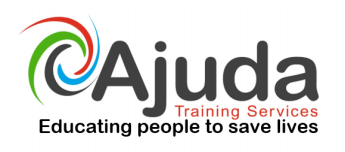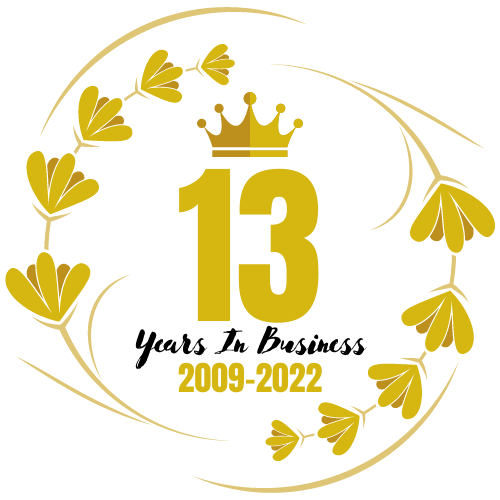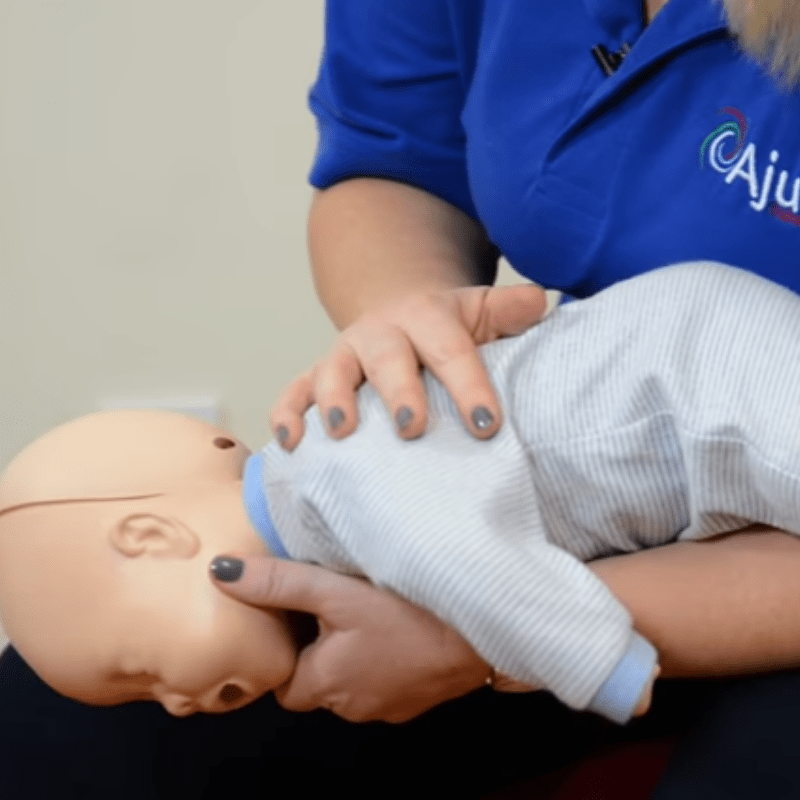Following the tragic news of the death of a five-year-old boy who choked on food at school in Hull two weeks ago, Ajuda would like to raise awareness about what to do in an emergency when a baby or a child is choking. Knowing what to do in these situations is an important life skill for anyone who spends time around children in a work or social setting. Here is a step by step guide on what to do when a child is choking.
Conscious Baby
1) Sit or kneel and lay the baby over your lap. Lay the baby face down on your forearm and hold your arm on your thigh to hold the baby steady. Support the chin with one hand and ensure that the head and neck are lower than the torso.
2) Using the heel of your free hand, deliver five blows between the shoulder blades – check the mouth each time.
3) If the object is not coughed up, turn the baby onto its back. Rest them on your forearm and use your thigh to support the body and your hand to steady the head and neck. Ensure that both the head and neck are lower than the torso.
4) Use two fingers to deliver five chest thrusts to the centre of the chest, directly on the breastbone and in between the nipples. Stop if the baby starts to cough so that they can cough up the object.
5) If they still can’t breathe, continue to alternate between five back blows and five chest thrusts until the airway is unblocked.
Unconscious Baby
1) Lay the baby on its back. To open the airway, tilt the head back and lift the chin.
2) Check to see if the baby is breathing normally by taking the cheek down to the mouth – listen, feel for breath on your cheek and look for the chest to rise and fall.
3) If baby is not breathing put your mouth over the nose and mouth to create a seal and give five initial rescue breaths (blow in just enough air to make the chest visibly rise). Take care not to over-inflate the lungs.
4) Combine rescue breaths with chest compressions: Use 2 fingers to depress the chest (on the sternum in the centre of the chest) at least a third of its depth (4cm).
5) Give 30 chest compressions at a rate of 100 – 120 per minute.
6) Open the airway again by tilting the head and lifting the chin, then give 2 more rescue breaths.
7) Continue this cycle until the baby regains consciousness If the baby doesn’t regain consciousness, continue with rescue breathing and chest compressions until professional help arrives. Ensure that you are checking for signs of normal breathing, coughing and movement every minute.
Conscious Child
1) Encourage the child to cough.
2) Back blows – stand to the side and lean the child forward whilst supporting them with one hand across the chest. Using the heel of the other hand deliver 5 back blows in between the shoulder blades progressively getting harder with each one and ensuring that you also check the mouth after each blow.
3) If the back blows are ineffective, the next stage is abdominal thrusts.
4) Stand or kneel behind child and wrap your arms around the waist.
5) Make a fist with one hand and place the thumb side on the child’s abdomen (below the ribs). Your fist should be positioned just above the navel and below the child’s breastbone.
6) Gently squeeze in and up sharply 5 times unless the object comes out.
7) Repeat these 2 stages until the object is expelled.
If you’ve had to perform abdominal thrusts on a child, it is important to seek medical attention even if they seem okay and the object has been expelled.
Unconscious Child
1) Lay child on their back. Open the airway by tilting the head back, lifting the chin and moving the tongue off the back of the throat.
2) Check for breathing. Look for the chest to rise and fall, listen with your ear next to the mouth and feel for breath on your cheek.
3) If you establish that the child is breathing, put them into the recovery position.
4) If the child is not breathing, commence with CPR. With the head still tilted back, seal your mouth over the child’s mouth (but not the nose) and pinch their nose. Blow steadily into the mouth until the chest rises. Remove your mouth and allow the chest to fall. Repeat four more times.
5) Combine rescue breaths with chest compressions – lean over the child, with your arm straight, place the heel of one hand in the centre of the chest over the lower half of the breastbone. Press the chest down by at least one-third of its depth. Repeat this 30 times at a rate of about twice a second.
6) Open the airway again by tilting the head and lifting the chin, then give two more rescue breaths.
7) Continue with chest compressions and rescue breaths at a ratio of 30:2 until the child regains consciousness or professional help arrives. Ensure to check for signs of normal breathing, coughing and movement each minute.
When to step in:
It is important to call for emergency help and start these rescue steps if your child shows any of these signs:
– Inability to talk, swallow, cry or make any sort of noise
– Blue lips or skin
– Inability to breathe
– Loss of consciousness
When not to step in:
Believe it or not, however much we want to rush to a child’s aid, there are times when applying these rescue steps can cause more harm than good. If your child can do any of the following, this means that the airway is only partially blocked and trying to unblock it could make it worse:
– Coughing
– Talking
– Crying
– Breathing


